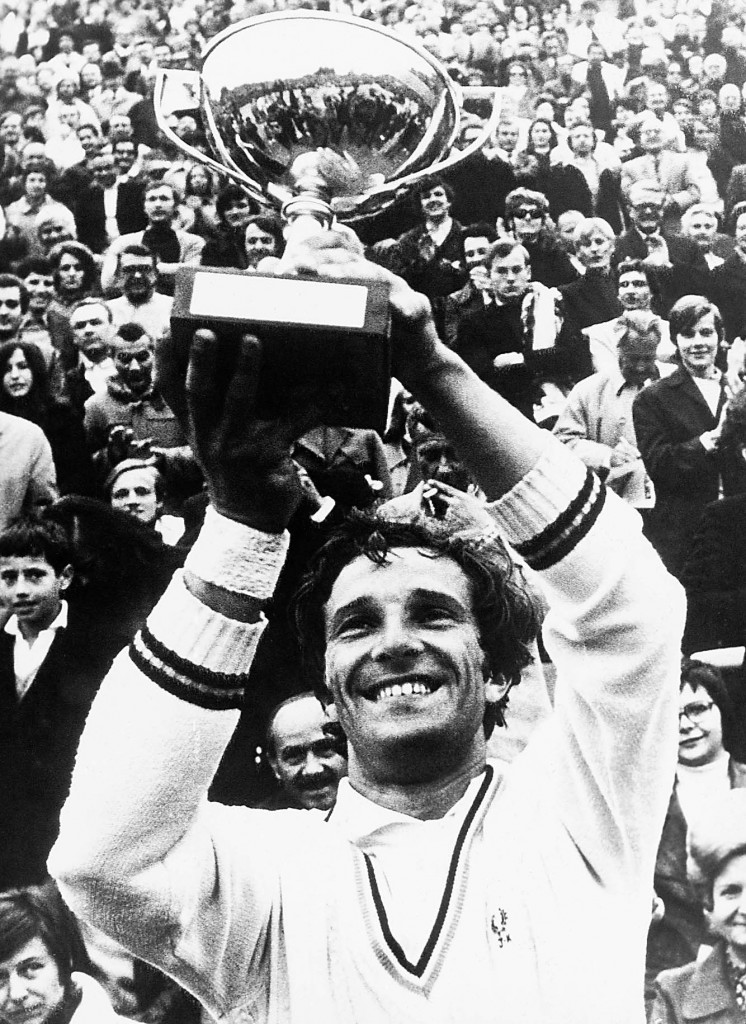It was 40 years ago at Roland Garros that, for only the fifth time since World War II that a player repeated as men’s singles champion. That player was the Czech Hall of Famer Jan Kodes. In his book JAN KODES: A JOURNEY TO GLORY FROM BEHIND THE IRON CURTAIN (Available here for 37.96 – http://amzn.to/lJYb4r), Kodes and co-author Peter Kolar review the circumstances where the Czech great successfully defending his French title. Autographed copies of the book are available from New Chapter Press and can be purchased directly via email at NewChapterPress@gmail.com. The excerpt is found below:
In the second round of Davis Cup we defeated Portugal easily 5:0 at Stvanice Island. Next on the agenda was Paris and Jan’s defense of the title from 1970. As the previous year’s champion, Jan Kodes was seeded as number one. Several professionals from Lamar Hunt’s group ignored Roland Garros and the organizers decided to make the draw for the remaining favorites very challenging. Fortunately, neither the first round opponent Pole Wieslaw Gasiorek nor the third round opponent Australian Bob Carmichael gave Kodes much resistance. But the host country players did.
The French thought highly of me after the 1970 French Open. Within a couple of days Pierre Darmon met me on the way from practice and said: “Jan, we are well aware of the difficult political atmosphere in your country. Under the authorization of the president of the French Tennis Federation I want to relate to you one thing; should you need help we are prepared to offer you an asylum and accept you in our tennis training camp. If you would like to stay in France we’ll get you an apartment, you’ll receive appropriate salary, and we’ll help you with everything you should require.”
I thanked him and responded with fleeting indecision and vacillation. I did not say yes or no. At any rate, it planted a bug in my head. I felt that in spite of the 1968 Invasion by the Warsaw Pact Armies the situation at home was not so terrible. That is to say that I traveled abroad most of the time playing tournaments thus I was unaware of the country’s developments. However, conditions began to worsen. Personally, I lucked out in a way that I won Roland Garros twice at the time when “normalization” was taking place full speed. It would have been difficult, I imagine, to get rid of someone who becomes twice the Grand Slam champion…
For me the Roland Garros matches were immensely taxing in the sense that the French players mustered up amazing performances in front of their home audience and other favorites thus faced tremendous challenges. That year I met a host country’s player three times! I played Jean-Pierre Courcol in the second round, Francois Jauffret in the sixteens, and Patrick Proisy in the quarter-finals.
It was Jauffret who tormented me the most; he was ahead two sets to one but I won in the end in five sets. It was a very difficult match and after the finals with Ilie Nastase, I considered it the second most challenging match I played there. I surrendered one set even to Proisy. The French thought out a strategy against me that proved to be effective. They wore me out first and then they attacked me in the middle of the court which eliminated me from hitting sharp angles. They made me work dreadfully hard!
The following story proves how popular Jan Kodes was in France already after his first triumph in 1970; it transpired a year later about the time when Pierre Darmon offered Jan asylum.
Benny Berthet, the ex-player and official of the French Federation, decided to make a gesture of offering all seeded players a car. Customarily, the players used taxis or subway to move around; there was no official form of transport. The organizers found a sponsor and all of us, seeded players, obtained car keys. We were free to travel around Paris any way we wanted to and the organizer did not need to worry about us. It was a nice development; no more walking to and from the subway with a tennis bag full of rackets over the shoulder. Once, with my coach returning to the hotel from dinner at around 10:30 pm
I crossed the intersection at the Place de Ternes on a orange light – not yet red. I got pulled over immediately by the traffic police and I felt my heart sink. Korda advised me: “Say that you are Kodes.” I opened the door but I knew very little French, only a couple of words. The policeman started telling me something so I pulled out my passport and he peeked inside and said: “Tchecoslovaquie? Kodes? C’est vous?” “Oui, c’est moi. Joueur de tennis!” He saluted, returned my passport and we drove off. Korda uttered: “You see, moron!” – It proved that my victory in France had multi-effects. Zeljko Franulovic had no chance against Kodes in the semifinals. Just like after the finals the year before he left the court with his head lowered after only three sets. Kodes won 6:4, 6:2, 7:5 and was on his way to face the old rival, the Romanian Nastase, in the finals.
We met in front of the locker room and he appeared poised and confident. When I looked at him I was struck by an audacious thought: pull it off like last year! This was the third time we would meet each other in Paris. Beat him… and show him some revenge compounded with “interest” for the shameful five-set defeat in 1966, when I played in Roland Garros for the first time.
Ilie was then among the absolute world top players. In 1969, he and Tiriac comprised one of the best and most successful European doubles teams in Davis Cup competition. They beat the US team in the finals that year and repeated the triumph again in 1971 and 1972. Jan Kodes competed with Nastase numerous times in his career and in most of those encounters the battles were exhausting and frightfully difficult. The 1971 finals in Paris was no exception. Kodes won the first two sets 8:6 and 6:2, Nastase took the third 6:2. A particular point in the fourth set most likely decided the outcome of the entire match.
I must state here that I was physically well conditioned in 1971. All of a sudden, it was all the same to me whether the match would stretch out only to two or to five sets. Yes, the rallies were grueling but I felt much better than in the previous years. And the final with Nastase was a perfect example of that. Nastase will never forgive me a situation that popped up then. I was up two sets to one, and in the fourth set he was leading 3:1 and had three breakpoints to 4:1 on my serve. If he had turned one of those chances into a game won, we would have, most likely, gone into the fifth set.
He drop-shotted me and I ran it down; however, in order to play it back successfully I had to dive for the ball in the style of later Boris Becker. I hit a very difficult volley in flight and landing on my knees. I remained lying on the ground and he must have thought that I would not get up again thus he hit a dinky shot right next to me. However, I sprung up, leaned into the shot, and put the ball away. The stands went crazy!
That turned things around. I broke Nastase’s serve and won the fourth set 7:5. With it I triumphed in the final match. Ilie has not been able to swallow that till today. Whenever we meet he calls me a “trickster” because I had acted like I was worn out, yet I had enough vigor to play the point.
“You whimper all the time and yet you continue to play!” I heard this sentence from him perhaps a thousand times.
And then it was over. The racket flew up in the air; Kodes jumped over the net and extended his hand to frowning Nastase.
I realized at that moment that I defeated a very formidable opponent. And here, at Roland Garros! On Parisian clay that I liked so much and where I always felt I could perform my best. My coach, Pavel Korda, was running towards me and we plunged into an embrace. Then the rest of my supporters came up. I wasn’t taking notice of what my coach was telling me, and I wasn’t conscious of the photographers either. I was only soaking up the fact that I won here for the second time!
A forty minute press conference followed and only after that a massage at last. The skilful hands of my friend Robert Laurens, French masseur kneaded and rubbed my weary muscles. He was still lying on the table when Ivan Lichner walked in. “Jan, do you even fathom what you have accomplished?” he addressed directly Kodes’ fresh achievement. “Only four players won Paris twice in succession since the end of the Second World War! The American Frank Parker in 1948 and 1949, our Jaroslav Drobny in 1951 and 1952, then another American Tony Trabert in 1954 and 1955, and Nicola Pietrangeli in 1959 and 1960. Not even Lew Hoad, nor Ken Rosewall, nor Rod Laver pulled it off. Only now – you have!”
Jan Kodes: A Journey To Glory From Behind The Iron Curtain is published by New Chapter Press – also the publisher of Tennis Made Easy by Kelly Gunterman, Roger Federer: Quest for Perfection by Rene Stauffer (www.RogerFedererBook.com), The Bud Collins History of Tennis by Bud Collins, The Education of a Tennis Player by Rod Laver with Bud Collins, Acing Depression: A Tennis Champion’s Toughest Match by Cliff Richey and Hilaire Richey Kallendorf (www.CliffRicheyBook.com), A Player’s Guide To USTA League Tennis by Tony Serksnis, On This Day In Tennis History by Randy Walker (www.TennisHistoryBook.com), Boycott: Stolen Dreams of the 1980 Moscow Olympic Games by Tom Caraccioli and Jerry Caraccioli (www.Boycott1980.com), The Lennon Prophecy by Joe Niezgoda (www.TheLennonProphecy.com), Bone Appetit, Gourmet Cooking For Your Dog by Susan Anson, The Rules of Neighborhood Poker According to Hoyle by Stewart Wolpin, People’s Choice Cancun – Travel Survey Guidebook by Eric Rabinowitz and Weekend Warriors: The Men of Professional Lacrosse by Jack McDermott, among others. New Chapter Press will also be publishing the memoir of 1931 Wimbledon champion Sidney Wood called The Wimbledon Final That Never Was…due out in June, 2011. Founded in 1987, New Chapter Press is an independent publisher of books and part of the Independent Publishers Group. More information can be found at www.NewChapterMedia.com.


